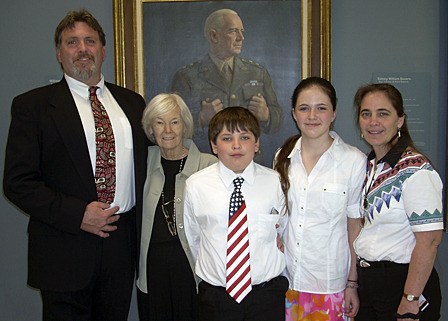Letitia Flint knew him as Uncle Bill, the man who was always there for her.
The history books know him as much more: father of the CIA.
Letitia’s son, Norm Flint, a long-time resident of Orcas Island, always knew his mom’s dream was to see the bronze statue of Donovan in the entry of the CIA building.
“When I asked the first time, the guy laughed at me,” Norm said. “So I said, ‘who can I talk to who won’t laugh at me?’ I spoke to a woman, explained about my mom, and she called back a week later to tell us they’d be thrilled to host the family of William Donovan.”
Letitia, Norm, his wife Becky, and their children Melanie, 13, and Ryan, 10, were accompanied by other members of the Flint family on a private tour of the CIA building on April 8, something the majority of civilians will never get to do.
“It was really awesome for my mom because they treated her like a celebrity,” Norm said. “The curator of the (CIA) museum had been there for 30 years and had never spoken to a family member of William Donovan.”
Letitia’s father died four days before Christmas, and it was Uncle Bill who stepped in to help. He paid for her education (first at Trinity Catholic School in New York and later college), went to every holiday and get-together, and was a father figure to the young girl.
“He always had time for her,” Norm said. “He was a wonderful man. He treated her like his own child … He was quiet. He never talked about his work.”
Oh what dinner conversation that would have made.
Before there was the CIA, there was the Office of Strategic Services. And Donovan ran it all.
Known as the “Father of Central Intelligence,” Major General Donovan was a highly decorated American soldier, lawyer and intelligence officer who was appointed by President Franklin D. Roosevelt in 1941 to bring together the various government intelligence departments. At the time, intelligence operations were fragmented. The organization quickly grew with what history books call his “charisma and zeal.” Under his leadership, the OSS conducted espionage and sabotage missions in Europe and parts of Asia.
As World War II came to a close, Donovan began focusing on preserving the work of OSS beyond the war. President Harry Truman disbanded the OSS in 1945, and Donovan returned to civilian life. But segments of the OSS survived, and two years later, the CIA was founded.
Letitia remembers visting Donovan at his OSS office in New York, and while his position wasn’t a secret, the family never really knew what his job entailed.
“It’s a part of American history that is so close to our family. It’s amazing,” Norm said.
In addition to viewing the CIA facility, the Flints visited the Vietnam war exhibit and a replica of Donovan’s OSS office.
Ryan says he enjoyed seeing Donovan’s many medals.
“The whole thing was really fun,” he said.
Donovan died when Letitia was 32, just a few months before Norm was born. The tour of the CIA building was both emotional and very gratifying for her.
“She broke down and started crying at the statue,” Norm said. “But my mom was elated. She found it amazing that his ideas are still in use today.”




